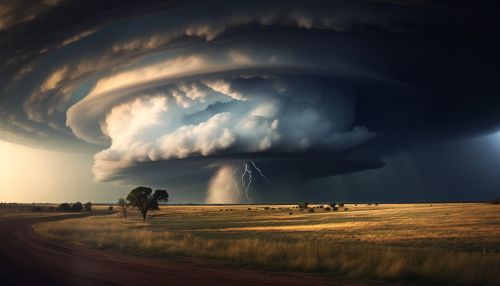Tornado climatology
Introduction
Tornado climatology is the scientific study of the distribution, frequency, and patterns of tornadoes in different regions around the world. It is a specialized branch of meteorology that seeks to understand the atmospheric conditions that lead to the formation of these powerful and often destructive weather phenomena. This field of study is crucial for improving our ability to predict tornadoes and mitigate their impacts.
Tornado Formation
Tornadoes form from severe thunderstorms, specifically those that exhibit strong rotation. These storms, known as supercells, are characterized by a persistent, rotating updraft of air. The rotation is a result of wind shear, a difference in wind speed or direction over a relatively short distance in the atmosphere.


The process begins with the formation of a mesocyclone, a rotating column of air within the supercell. As the mesocyclone strengthens, it can tighten and intensify, leading to the formation of a tornado. However, not all mesocyclones produce tornadoes, and the exact conditions that lead to tornado formation are still a topic of ongoing research in tornado climatology.
Tornado Classification
Tornadoes are classified based on their intensity and the damage they cause. The most commonly used scale is the Enhanced Fujita (EF) scale, which replaced the original Fujita scale in 2007. The EF scale ranges from EF0, for tornadoes causing light damage, to EF5, for those causing incredible damage.
Global Distribution of Tornadoes
While tornadoes can occur almost anywhere in the world, they are most common in the United States, particularly in a region known as Tornado Alley. This area, which includes parts of Texas, Oklahoma, Kansas, and Nebraska, sees a high number of tornadoes each year due to its unique geographical and atmospheric conditions.
However, other regions around the world also experience tornadoes. These include parts of South America, Europe, Asia, and Australia. In Europe, for example, the United Kingdom has the highest number of reported tornadoes per unit area per year.
Seasonal and Diurnal Patterns
Tornadoes can occur at any time of year, but they are most common in the spring and early summer. This is when conditions are most favorable for the formation of severe thunderstorms. In the United States, the peak tornado season varies by region. In the southern states, it is typically in the spring, while in the northern states, it is in the early summer.
Tornadoes can also occur at any time of day, but they are most likely to occur in the late afternoon and early evening. This is when the atmosphere is typically the most unstable, due to the heating of the earth's surface by the sun.
Tornado Climatology and Climate Change
The impact of climate change on tornado climatology is a topic of ongoing research. Some studies suggest that while the overall number of tornadoes may not increase, the number of severe tornadoes (EF4 and EF5) could increase due to a warmer and more humid atmosphere. However, this is still a topic of debate among scientists.
